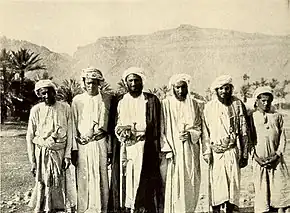السقطريون | |
|---|---|
 Soqotri people, 1918 | |
| Total population | |
| 71,400[1] | |
| Regions with significant populations | |
| Languages | |
| Soqotri | |
| Religion | |
| Islam | |
| Related ethnic groups | |
| Other Semitic-speaking peoples Especially Harasis, Mehri, and other Modern South Arabian-speaking peoples |
The Soqotri people, sometimes referred to as Socotran, are a South Arabian ethnic group native to the Gulf of Aden island of Socotra. They speak the Soqotri language, a Modern South Arabian language in the Afroasiatic family.
General
.jpg.webp)
The Soqotri primarily inhabit the Socotra Archipelago, on Socotra island and the Abd al Kuri, Darsah and Samhah districts of the Amanat Al Asimah governorate, Yemen.[1]
According to Ethnologue, there are an estimated 71,400 Soqotri. As of the last 1990 Socotra census, they numbered around 57,000.[1]
Most Soqotri are Sunni Muslim.[1] Historically, Soqotri were Nestorian Christians, from the Christianization of the island between the 4th and 6th centuries up until the 15th century, when the island was occupied by the Mehri Sultanate in 1480.[2] This led to slow Islamisation of the Soqotri.[3]
Language
.jpg.webp)
The Soqotri speak the Soqotri language (also known as Saqatri, Socotri, Sokotri and Suqutri). It belongs to the Modern South Arabian languages which are closer to the Ethiopian Semitic languages than to Arabic (Central Semitic languages). Despite historical contacts with the Arabic language, there is no mutual understanding between native speakers of the Modern South Arabian languages and native speakers of Arabic. Moreover, there is no mutual understanding between the speakers of the Modern South Arabian languages themselves, and the Soqotri language is only spoken on the island of Socotra.[4]
Soqotri has several dialects, which consist of ’Abd Al-Kuri, Central Soqotri, Northern Soqotri, Southern Soqotri and Western Soqotri. North Soqotri comprises North Central and Northwest Central (highland) Soqotri.[1]
The language is written using the Naskh variant of the Arabic script. Soqotri is also transcribed with the Latin script.[1]
Genetics
Most Soqotri belong to the paternal haplogroup J, bearing the basal J*(xJ1,J2) clade at its highest frequencies (71.4%). The remaining individuals mainly carry the J1 subclade (14.3%).[5] YFull[6] and FTDNA[7] have however failed to find J* people anywhere in the world although there are 2 J2-Y130506 persons and 1 J1 person from Soqotra.
Maternally, the Soqotri primarily belong to the haplogroups N (24.3% N*; 6.2% N1a) and R0 (17.8% R0a1b; 13.8% R0a; 6.2% R0a1). The basal N* clade occurs at its highest frequencies among them. The next most common mtDNA lineages borne by Soqotri individuals are the haplogroups J (9.2% J*; 3.1 J1b), T (7.7% T2; 1.2% T*), L3 (4.3% L3*), H (3.1%), and R (1.2 R*).[5]
See also
Notes
- 1 2 3 4 5 6 "Soqotri". Ethnologue. Retrieved 19 May 2017.
- ↑ Jansen van Rensburg, Julian (December 2018). "Rock Art of Soqotra, Yemen: A Forgotten Heritage Revisited". Arts. 7 (4): 99. doi:10.3390/arts7040099. ISSN 2076-0752.
- ↑ Loimeier 2013, p. 181.
- ↑ Simeone-Senelle 2003, p. 2.
- 1 2 Černý, Viktor; et al. (2009). "Out of Arabia—the settlement of island Soqotra as revealed by mitochondrial and Y chromosome genetic diversity" (PDF). American Journal of Physical Anthropology. 138 (4): 439–447. doi:10.1002/ajpa.20960. PMID 19012329. Archived from the original (PDF) on 6 October 2016. Retrieved 18 May 2017.
- ↑ "J YTree".
- ↑ "Y-DNA J Haplogroup Project". FamilyTreeDNA.